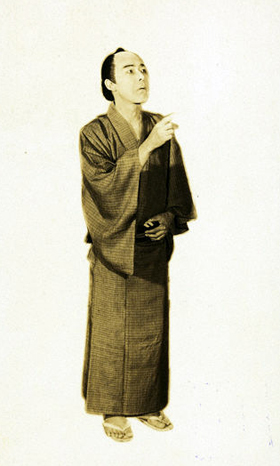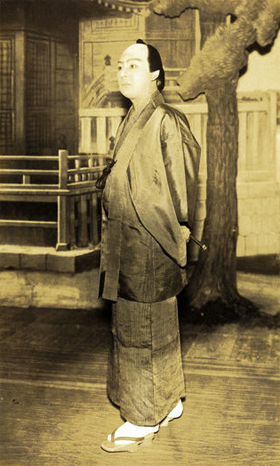| JÔSHÛ MIYAGE HYAKURYÔ KUBI |
| Play title | Jôshû Miyage Hyakuryô Kubi Souvenir of Jôshû: A Valuable Head |
| Author | Kawamura Karyô |
| History |
Kawamura Karyô's drama "Jôshû Miyage Hyakuryô Kubi" was premiered in September 1933 at the Tôkyô Gekijô [more details]. |
| Structure |
"Jôshû Miyage Hyakuryô Kubi" was made up of 3 acts divided into 6 scenes. |
| Key words |
Asakusa Bakumatsu Goyôkiki Hanakawado Jôshû Matsuchiyama Shôden Miyage Okappiki Ryôrinin Ryôtei Sewamono Shinkabuki Shitaya Suri Torikata Yusuriba |
| Summary |
Act I, scene 1: Shitaya Kinteki Yoichi Sumai This drama is set in the late Edo period (Bakumatsu). In the backstreets of Shitaya, there is a rented house where the pickpocket (suri) Kinteki no Yoichi [1] lives with his fellow thieves Mikurumi no Sanji [2] and Itaba no Shôtarô [3]. Shôtarô returns home empty-handed from a day of 'work'. The reason, he says, is because he has run into a close childhood friend whom he has not met for 15 years. His friend, Buraikan Gajirô [4], has always been an awkward and clumsy fellow, Shôtarô explains, but, on the positive side, is also known for his affability and good humor. In their childhood, Shôtarô has always looked upon Gajirô as his younger brother. To celebrate their chance reunion Shôtarô treated his friend to a great meal, and when it has been time to say goodbye, Gajirô was so moved by their unexpected meeting that he has hugged Shôtarô. Reflexively, and without thinking, Shôtarô has made a grab for Gajirô's wallet, and is now deeply regretting this unwanted betrayal of trust. Soon Shôtarô notices that his own wallet is missing and he realizes that it has been lifted by the clumsy Gajirô. Shôtarô is overcome by sadness and resigns himself to never being able to face Gajirô again. Gajirô arrives at Yoichi's home. He tells Shôtarô that he has joined a group of pickpockets, but he is so clumsy that he has not been able to make a single theft yet. Shôtarô's wallet is the first that he has been able to successfully steal. Gajirô apologizes from the bottom of his heart and makes a decision to leave this dishonest lifestyle behind him, inviting Shôtarô to do the same. Shôtarô is moved by the appeal and decides to sever his ties with Yoichi, Sanji and the world of pickpocketing. While Yoichi gives his blessing to Shôtarô's change of heart, Sanji is reluctant to do so, vowing to one day to make Shôtarô pay for this happiness smelling honesty. Act I, scene 2: Matsuchiyama Shôden no Mori The scene is set in the forest of the Matsuchiyama Shôden Temple in Asakusa. Itaba no Shôtarô and Buraikan Gajirô vow to go their separate ways but to meet again exactly 10 years later at the very same spot to see how far they have been able to get in their bid to lead an honest life. They bid farewell inside the temple precincts under a bright, moonlit sky and promise to return again 10 years later. Act II, scene 1: Jôshû Tatebayashi no Ryôtei Tatsumi Zashiki Close to 10 years have elapse since Shôtarô left Kinteki no Yoichi and Mikurumi no Sanji behind to strike out on his own as an honest hard-working man. The scene is set in the zashiki of the ryôtei Tatsumi in Tatebayashi in the province of Jôshû. Kinteki no Yoichi and Mikurumi no Sanji are enjoying their first really sumptuous meal since being forced to leave Edo to avoid being arrested for all their petty crimes. They have disguised themselves as traveling merchants and are wandering about from one city to another. Quite pleased with the meal that reminds them of the best Edo had to offer, Yoichi leaves a generous tip for the cook (ryôrinin). Ubê, the restaurant owner comes to thank them, and brings the cook with him. Yoichi are Sanji are surprised to learn that it is no other than their former companion Shôtarô. Shôtarô, who has been a cook before becoming a thief, has been working diligently over the past 10 years and has won the trust of Ubê, who hopes Shôtarô will agree to marry his daughter Osode and take over the shop one day. Shôtarô, for his part, has been saving up little by little and now has a hefty sum of 200 ryô stashed away. He intends to give this money to Gajirô when they meet again in the hopes that Gajirô will be able to start a business with this amount. Act II, scene 2: Shôtarô Karizumai Shôtarô bids good night to the restaurant owner's daughter Osode, who is overjoyed that Shôtarô has agreed to marry her and to stay on at Tatsumi. He is walking back to his room when he runs into Mikurumi no Sanji, who has been waiting for Shôtarô to pass. Sanji demands that Shôtarô lends him the 200 ryô, which Shôtarô has unwittingly mentioned he has with him. Sanji blackmails him (yusuriba), saying that if Shôtarô does not hand over the money, he will tell Ubê about Shôtarô's deeds in the past. Shôtarô reluctantly hands over the money. When Sanji claims he will come back when the 200 ryô runs out, Shôtarô runs out of patience and kills his former friend. Act III, scene 1: Goyôkiki Kanji Sumai The scene is set the home of the goyôkiki Hayabusa no Kanji [5] in the district of Hanakawado in Asakusa. After parting from Shôtarô 10 years ago, Gajirô has successfully mended his ways and is now working as a follower of Hayabusa no Kanji's underlings. He has not outgrown his clumsiness, however, and, up to today, he has not been able to catch any thief since joining Kanji's squad. Desperate to accomplish something big that would make Shôtarô proud of him, he has been visiting a local shrine every day and offering prayers to have his wishes fulfilled. As Gajirô is about to make his final visit, he learns of a murderer on the loose whose capture carries a 100 ryô reward. The murderer, he learns, has not only killed a man in Tatebayashi but has also attacked two of his captors-receiving a big wound on his forehead in the struggle - and is headed for Edo. Gajirô sets his sights on making the arrest himself. Gajirô's colleagues laugh out loud at his intentions, scornfully chiding him that there is no way such a clumsy torikata as Gajirô could singlehandedly catch a criminal who has already once escaped well-trained torikata. Act I, scene 2: Matsuchiyama Shôden no Mori Like in the second scene of the first act, this final scene is set in the forest of the Matsuchiyama Shôden Temple in Asakusa. At night, Gajirô arrives at the temple where he and Shôtarô have agreed to meet again. Gajirô notices Shôtarô wearing a large woven hat in the shadows and runs over to hug him. Gajirô wants to invite Shôtarô up to his home, but tells him that he must visit a shrine one last day to see that his wish is fulfilled. With this Gajirô tries to slip away, but Shôtarô calls him back, saying there is no need for a final visit-all he needs to do is to tie Shôtarô up. With this he removes his hat, revealing a deep wound on his forehead. To Gajirô's horror, he realizes that the murderer on the run is his best friend Shôtarô, whom Gajirô has endearingly thought of as his older brother through the years. Unable to bring himself to make the arrest, he runs away. Shôtarô calls him back, but Gajiro cannot be stopped. Instead Kanji's torikata appear to make the sought-after arrest. In pleading tones, Shôtarô confesses that after the 200 ryô was taken away from by his initial captors, he has hoped to give the reward for his capture to Gajirô by allowing him to arrest him. Gajirô has hoped to set Shôtarô free, but as he realizes that that would not be possible, he tearfully pleads with his boss Hayabusa no Kanji to at least permit Shôtarô to turn himself in. Hayabusa no Kanji, realizing that this the least he can do, allows Gajirô to make the claim as the sole captor and to take the murderer into custody by himself. Gajirô and Shôtarô share what will probably be their last private moments together as they walk solemnly toward the magistrate's office. |
| Notes |
[1] Literally, Yoichi the Bull's Eye [2] Literally, Sanji the Walnut [3] Literally, Shôtarô the Cook |
 |
 |
|
The actors Nakamura Kichiemon I and Onoe Kikugorô VI playing the roles of Buraikan Gajirô and Itaba no Shôtarô in the drama "Jôshû Miyage Hyakuryô Kubi", which was staged in September 1933 at the Tôkyô Gekijô |
|
|
|
| Contact | Main | Top | Updates | Actors | Plays | Playwrights | Programs | Links | FAQ | Glossary | Chronology | Illustrations | Prints | Characters | Derivatives | Theaters | Coming soon | News |